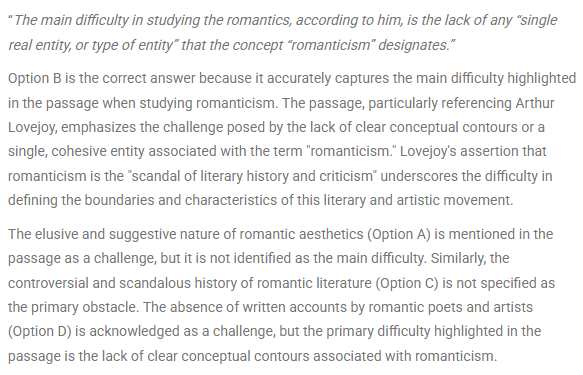CAT RC Questions | CAT RC Based on Humanities questions
FundaMakers is the Best CAT Online Coaching In India. Now prepare for CAT anytime with FundaMakers. We provide well-ordered syllabus coverage for both offline and online CAT preparation batches. FundaMakers brings to you the power-packed, well-structured CAT previous year question bank with more than 4000+ CAT Past Year questions. In the VARC section, one of the most frequently asked questions is from the topic- Reading Comprehension. Reading Comprehension turns out to be an important part of the VARC section from which over 60-70% of the questions are based on RC in the CAT Exam.
FundaMakers as a team has taken a painstaking step to bring you all the video solutions of the Reading Comprehension asked in the Previous Year CAT exam. CAT question bank offered by FundaMakers is a power-packed topic-wise compilation of the entire CAT previous year questions. Questions from the Reading Comprehension topic are some of the most scoring questions in the VARC section. To maximize your CAT score make use of FundaMakers CAT Question Bank. “Questions from CAT previous years” examination papers have been incorporated. Let’s get started with CAT Past Year Reading Comprehension Questions.
Comprehension
The passage below is accompanied by a set of questions. Choose the best answer to each question.
Understanding romantic aesthetics is not a simple undertaking for reasons that are internal to the nature of the subject. Distinguished scholars, such as Arthur Lovejoy, Northrop Frye and Isaiah Berlin, have remarked on the notorious challenges facing any attempt to define romanticism. Lovejoy, for example, claimed that romanticism is “the scandal of literary history and criticism” . . . The main difficulty in studying the romantics, according to him, is the lack of any “single real entity, or type of entity” that the concept “romanticism” designates. Lovejoy concluded, “the word ‘romantic’ has come to mean so many things that, by itself, it means nothing” . . . The more specific task of characterizing romantic aesthetics adds to these difficulties an air of paradox. Conventionally, “aesthetics” refers to a theory concerning beauty and art or the branch of philosophy that studies these topics. However, many of the romantics rejected the identification of aesthetics with a circumscribed domain of human life that is separated from the practical and theoretical domains of life. The most characteristic romantic commitment is to the idea that the character of art and beauty and of our engagement with them should shape all aspects of human life. Being fundamental to human existence, beauty and art should be a central ingredient not only in a philosophical or artistic life, but also in the lives of ordinary men and women. Another challenge for any attempt to characterize romantic aesthetics lies in the fact that most of the romantics were poets and artists whose views of art and beauty are, for the most part, to be found not in developed theoretical accounts, but in fragments, aphorisms and poems, which are often more elusive and suggestive than conclusive. Nevertheless, in spite of these challenges the task of characterizing romantic aesthetics is neither impossible nor undesirable, as numerous thinkers responding to Lovejoy’s radical skepticism have noted. While warning against a reductive definition of romanticism, Berlin, for example, still heralded the need for a general characterization: “[Although] one does have a certain sympathy with Lovejoy’s despair…[he is] in this instance mistaken. There was a romantic movement…and it is important to discover what it is” . . . Recent attempts to characterize romanticism and to stress its contemporary relevance follow this path. Instead of overlooking the undeniable differences between the variety of romanticisms of different nations that Lovejoy had stressed, such studies attempt to characterize romanticism, not in terms of a single definition, a specific time, or a specific place, but in terms of “particular philosophical questions and concerns” . . . While the German, British and French romantics are all considered, the central protagonists in the following are the German romantics. Two reasons explain this focus: first, because it has paved the way for the other romanticisms, German romanticism has a pride of place among the different national romanticisms . . . Second, the aesthetic outlook that was developed in Germany roughly between 1796 and 1801–02 — the period that corresponds to the heyday of what is known as “Early Romanticism” . . .— offers the most philosophical expression of romanticism since it is grounded primarily in the epistemological, metaphysical, ethical, and political concerns that the German romantics discerned in the aftermath of Kant’s philosophy.
Explanatory Answer
Method of solving this CAT RC Question from RC Based on Humanities question
Correct Option: B

Hey!
Worried about IIM calls due to your marks in 10th,12th, and Graduation?
Don't worry! Know your chances of getting an IIM Call based on your profile with our:-
Profile Professor: https://fundamakers.com/profile-professor/

5 Must- NOT-Dos during CAT Preparation.
- Do not treat CAT as 'Everything'.
- Do not quit your job for CAT exam preparation.
- Learning till The Eleventh hour instead of doing proper revision.
- Not checking the syllabus thoroughly.
- Piling up multiple books.
Click To Read:- Common mistakes made by CAT aspirants during preparation.
FundaMakers- Best Online and Offline CAT Online Preparation Institute in India
For any CAT Preparation related query, reach out to us at 9598333344.